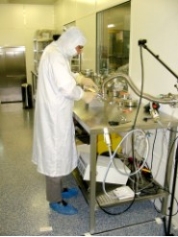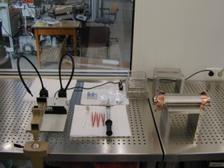Preparation for vacuum checking
One major contribution to this improvement is the consequent treatment and preparation of the cavities in clean rooms with procedures similar to standards in semiconductor industry [2]. Dust particles can act as field emitters and thus limit the performance of the superconducting cavities. Therefore dust particles need to be absolutely avoided.
The few K cold cavities are an integral part of the accelerator beam pipe. Thus the risk to contaminate the superconducting cavities with particles from the warm vacuum sections during assembly and operation must be minimized.
Key components in SR beamlines are mirrors used to deflect and tailor the photon beam for experimental needs. In this process there is a strong interaction with the beam. Hydrocarbons in the residual gas surrounding the mirror interacts with the SR beam. This will create SR cracked carbon deposition on the mirror surface changing drastically the optical properties of the mirror. To avoid this the hydrocarbon residual gas pressure of cleaned UHV parts has to be in the order of 10-3 of the achieved total pressure.
SR beamlines on free electron lasers or third generation SR sources like storage rings will have a large output of coherent photons. Especially in the X-ray regime dust on mirrors will destroy partly the coherence properties of the beam. To which extent particles on reflecting surfaces have to be avoided is still under investigation.
|
|
|








